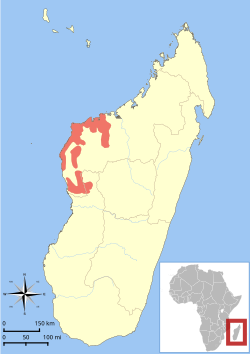| Von der Decken's sifaka | |
|---|---|
 | |
| Scientific classification | |
| Kingdom: | Animalia |
| Phylum: | Chordata |
| Class: | Mammalia |
| Order: | Primates |
| Suborder: | Strepsirrhini |
| Family: | Indriidae |
| Genus: | Propithecus |
| Species: | P. deckenii |
| Binomial name | |
| Propithecus deckenii | |
 | |
| Distribution of P. deckenii [1] | |
Von der Decken's sifaka (Propithecus deckenii) is a sifaka lemur that is endemic to the arid, deciduous and spiny succulent forests of Western Madagascar. [5] It has a length of 92 to 107 centimeters, of which 42-48 centimeters are tail. [5] The species is named in honor of the German explorer Karl Klaus von der Decken.
Its pelage is usually creamy white, with tinges of yellow-gold, silver-grey or pale brown on the neck, shoulders, back and limbs. The face is entirely black. [5] Group size is between two and ten individuals, with groups of three to six being the most common. [5]
The IUCN lists its status as critically endangered, and it is listed in CITES Appendix I. [1] [2]



